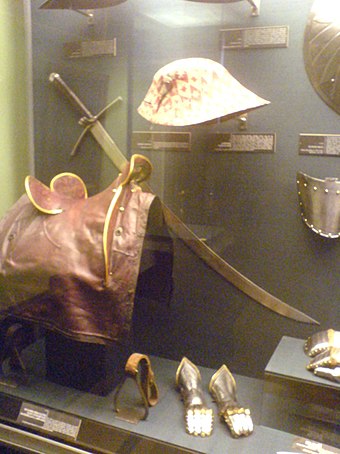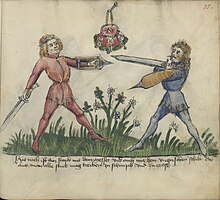378:
423:: a nail-like protrusion which projects out from the right side of the cross-guard perpendicular to the flat of the blade, which protects the knuckles of the wielder's hand from injury. On the smallest messers and most bauernwehr the nagel is usually driven through the wooden grips of the hilt. On larger messer, a steel cross-guard is normally found, and the nagel is slotted through a hole in the centre of the cross-guard. The length of the hilt is normally proportionate to the length of the blade, with longer blades featuring hilts long enough to enable gripping with both hands.
296:("war knife") are the largest examples of messer-hilted weapons, ranging from around 1 m (3 ft 3 in) long with approximately 80 cm (31 in) blade, up to around 1.35 m (4 ft 5 in) long with blades up to 1 m (3 ft 3 in) in length. Designed to be used with both hands, such messers were dedicated military arms, normally wielded by professional soldiers during the 15th and 16th century, such as the
36:
290:("knife", "long knife", and "great knife" respectively) are usually single-handed swords used for self-defence. These blade lengths ranged from about 45 cm (18 in) to 90 cm (35 in). Hilts are normally suited to single handed use, but the larger examples may feature extended grips suitable for a second hand-hold.
364:
is German, messer hilted arms have been found in multiple
European nations, with local or regional names. Examples of messer are found in the Netherlands and Northern France, Iceland, Sweden, and the Baltic Nations, in the central European nations of Poland, Czechia, Hungary and Romania, and to the
404:
Messer are characterized by single-edged blades mounted on knife-like hilts. The lengths and shape of blades can vary greatly, with straight or curved profiles, broad or narrow blades, and presence or absence of fullers. Extant examples of langes messer seem to have an overall length of 30 in
144:
434:
like contemporary two-edged swords. Instead, those which have a metal pommel tend to feature asymmetrical profiles which curve down towards the edged side of the blade - a feature which is sometimes called a "Hat shape", or a "bird's beak" pommel. Some examples terminate in ovoid metal caps which
426:
While the majority of messer hilts are constructed of wood, a small proportion of extant examples exhibit hilts of other materials - horn, bone, or leather-covered wood. A smaller section yet display highly complex hilt construction techniques, using metal frame construction containing organic
368:
The geographical spread of messers can be traced from known centres of manufacture in areas like Passau and
Solingen, through medieval river trade routes, and the shipping networks of the Hanseatic League. As such, It is most likely that very similar messer hilts found in for example, Iceland,
312:
To combat the inherent uncertainties in using the period terms like "Messer", "langes Messer", and "Großes Messer" which are sometimes interchangeable, there is a typology created by James G. Elmslie for
European single-edged arms, which classifies messer and
348:
civilian knives of low social status. As such their exact date of origin is uncertain, the earliest known depiction being from around 1430. Those knives grow steadily larger, and depictions of sword-sized messer are found by the end of the 1440s in
303:
These names are subjective, and there are no known texts which clearly codify the differences between groups. As such, A large
Bauernwehr might well have also been called a Messer, or a large Großes Messer might have been called a Kriegsmesser.
438:
Messer hilt construction techniques develop over time, and in the 16th century, sometimes begin to match contemporary two-edged sword construction methods, to the point that it is difficult to differentiate between the two groups.
408:
The principal feature of the messer is its hilt construction, which is usually different to that of contemporary
European swords. Most messer are assembled with the hilt consisting of a slab
276:("home/household knife") is a single-handed knife, used for utility and defence. Typical blade lengths range from 15 cm (5.9 in) lengths up to around 35 cm (14 in).
572:
Barbara
Grotkamp-Schepers, Isabell Immel, Peter Johnsson, Sixt Wetzler: "Das Schwert. Gestalt und Gedanke: The Sword. Form and Thought" Deutsches Klingenmuseum. Solingen, 2015,
369:
northern
Germany, and northern Poland are evidence of export of Passau blades during the late 15th and early 16th centuries, rather than examples of indigenous manufacture.
336:
Messer appear to have emerged in the region of
Southern Germany, Switzerland, or Northern Austria in the first few years of the 15th century, as small
630:
635:
377:
601:
100:
548:
72:
660:
119:
79:
675:
448:
670:
665:
427:
panels, such as exotic wood and mother-of pearl, or chequerboard patterns constructed from bone and dark horn.
53:
577:
57:
435:
form a flat face, and some have no metal terminal at all, instead being plain wood, or leather-covered wood.
86:
405:(76 cm) with a 24.5 in (62 cm) blade, and a weight between 2–2.5 lb (0.91–1.13 kg).
17:
458:
396:
680:
265:
While the various names are often used synonymously, messers can be divided into several principal groups:
68:
655:
650:
149:
544:
46:
499:
465:
365:
south of
Germany in Switzerland, Austria, Slovenia, and northern parts of the Balkan nations.
93:
8:
318:
597:
573:
474:
487:
386:
326:
247:
479:
322:
625:
620:
553:
644:
409:
519:
391:
297:
483:
524:
352:
143:
35:
504:
314:
431:
558:
514:
509:
413:
153:
554:"Langes Messer or long knife - the Germanic falchion-relation"
255:
251:
219:
165:
626:
Video interpretation of several of Lecküchner's Messer Plays
259:
230:
258:
of the 15th and 16th century, characterised by knife-like
236:
Cruciform and riveted, with end cap or pommel and nagel
621:
Video interpretation of Four
Sources on Messer Combat
60:. Unsourced material may be challenged and removed.
464:of the 14th and 15th centuries, including that of
642:
416:plates which are pinned or riveted into place.
591:
272:("peasant's knife" or "peasant's sidearm") or
350:
343:
337:
596:. Yale University Press. pp. 102–103.
442:
120:Learn how and when to remove this message
376:
331:
14:
643:
594:The martial arts of Renaissance Europe
457:was part of the curriculum of several
587:
585:
58:adding citations to reliable sources
29:
24:
193:0.96–1.4 kg (2.1–3.1 lb)
25:
692:
614:
592:Anglo, Sydney; B. Norman (2000).
582:
449:Historical European martial arts
142:
34:
430:Messer do not normally feature
372:
45:needs additional citations for
566:
537:
412:sandwiched between two wooden
201:75–113 cm (30–44 in)
13:
1:
530:
209:62–85 cm (24–33 in)
7:
493:
400:fol. 55r, mid 15th century)
325:. For more information see
307:
180:15th century – 16th century
10:
697:
446:
419:Messer usually feature a
229:
218:
213:
205:
197:
189:
184:
176:
171:
161:
141:
134:
661:Medieval European swords
631:James Elmslie's Research
443:Fighting with the messer
262:construction methods.
150:Kunsthistorisches Museum
676:Renaissance-era weapons
671:Renaissance-era swords
666:Medieval blade weapons
401:
351:
344:
338:
321:used for double-edged
317:forms, similar to the
148:A Kriegsmesser in the
447:Further information:
380:
254:") is a single-edged
636:The Elmslie Typology
332:Origin and geography
54:improve this article
681:Single-edged swords
500:Johannes Lecküchner
466:Johannes Lecküchner
69:"Messer" sword
468:(dealing with the
462:(fighting manuals)
402:
319:Oakeshott typology
603:978-0-300-08352-1
475:Codex Wallerstein
327:Elmslie Typology.
240:
239:
206:Blade length
130:
129:
122:
104:
16:(Redirected from
688:
656:European weapons
608:
607:
589:
580:
570:
564:
563:
541:
387:Hungarian shield
381:Fighting with a
356:
347:
341:
146:
137:
132:
131:
125:
118:
114:
111:
105:
103:
62:
38:
30:
21:
696:
695:
691:
690:
689:
687:
686:
685:
651:European swords
641:
640:
617:
612:
611:
604:
590:
583:
571:
567:
552:
549:Wayback Machine
542:
538:
533:
496:
451:
445:
375:
360:While the name
334:
310:
214:
177:In service
172:Service history
157:
135:
126:
115:
109:
106:
63:
61:
51:
39:
28:
23:
22:
15:
12:
11:
5:
694:
684:
683:
678:
673:
668:
663:
658:
653:
639:
638:
633:
628:
623:
616:
615:External links
613:
610:
609:
602:
581:
565:
535:
534:
532:
529:
528:
527:
522:
517:
512:
507:
502:
495:
492:
488:Albrecht Dürer
480:Hans Talhoffer
444:
441:
374:
371:
333:
330:
309:
306:
238:
237:
234:
227:
226:
223:
216:
215:
211:
210:
207:
203:
202:
199:
195:
194:
191:
187:
186:
185:Specifications
182:
181:
178:
174:
173:
169:
168:
163:
159:
158:
147:
139:
138:
128:
127:
42:
40:
33:
26:
9:
6:
4:
3:
2:
693:
682:
679:
677:
674:
672:
669:
667:
664:
662:
659:
657:
654:
652:
649:
648:
646:
637:
634:
632:
629:
627:
624:
622:
619:
618:
605:
599:
595:
588:
586:
579:
575:
569:
561:
560:
555:
550:
546:
540:
536:
526:
523:
521:
518:
516:
513:
511:
508:
506:
503:
501:
498:
497:
491:
489:
485:
481:
477:
476:
471:
470:langes messer
467:
463:
461:
456:
450:
440:
436:
433:
428:
424:
422:
417:
415:
411:
406:
399:
398:
394:
393:
388:
384:
379:
370:
366:
363:
358:
355:
354:
346:
340:
329:
328:
324:
323:arming swords
320:
316:
305:
301:
299:
295:
291:
289:
288:Großes Messer
285:
284:Langes Messer
281:
277:
275:
271:
266:
263:
261:
257:
253:
249:
245:
235:
232:
228:
224:
221:
217:
212:
208:
204:
200:
196:
192:
188:
183:
179:
175:
170:
167:
164:
160:
155:
151:
145:
140:
133:
124:
121:
113:
102:
99:
95:
92:
88:
85:
81:
78:
74:
71: –
70:
66:
65:Find sources:
59:
55:
49:
48:
43:This article
41:
37:
32:
31:
19:
18:Langes Messer
593:
568:
557:
545:Ghostarchive
543:Archived at
539:
473:
469:
459:
454:
452:
437:
429:
425:
420:
418:
407:
403:
395:
390:
382:
373:Construction
367:
361:
359:
335:
311:
302:
294:Kriegsmesser
293:
292:
287:
283:
279:
278:
273:
269:
267:
264:
243:
241:
225:Single-edged
116:
107:
97:
90:
83:
76:
64:
52:Please help
47:verification
44:
520:Swiss degen
460:Fechtbücher
392:Gladiatoria
353:Fechtbücher
298:Landsknecht
27:Cold weapon
645:Categories
578:3930315408
531:References
484:Paulus Kal
339:Bauernwehr
270:Bauernwehr
233: type
222: type
80:newspapers
525:Zhanmadao
397:Fechtbuch
110:July 2021
547:and the
505:Falchion
494:See also
345:Hauswehr
315:falchion
308:Typology
274:Hauswehr
559:YouTube
515:Nodachi
510:Machete
472:), the
432:pommels
385:and a "
286:, and
136:Messer
94:scholar
600:
576:
455:messer
383:Messer
362:messer
280:Messer
248:German
244:messer
198:Length
154:Vienna
96:
89:
82:
75:
67:
421:Nagel
256:sword
252:knife
250:for "
220:Blade
166:Sword
101:JSTOR
87:books
598:ISBN
574:ISBN
486:and
453:The
414:grip
410:tang
357:.
342:and
260:hilt
231:Hilt
190:Mass
162:Type
73:news
389:" (
56:by
647::
584:^
556:.
551::
490:.
482:,
478:,
300:.
282:,
268:A
242:A
152:,
606:.
562:.
246:(
156:.
123:)
117:(
112:)
108:(
98:·
91:·
84:·
77:·
50:.
20:)
Text is available under the Creative Commons Attribution-ShareAlike License. Additional terms may apply.

